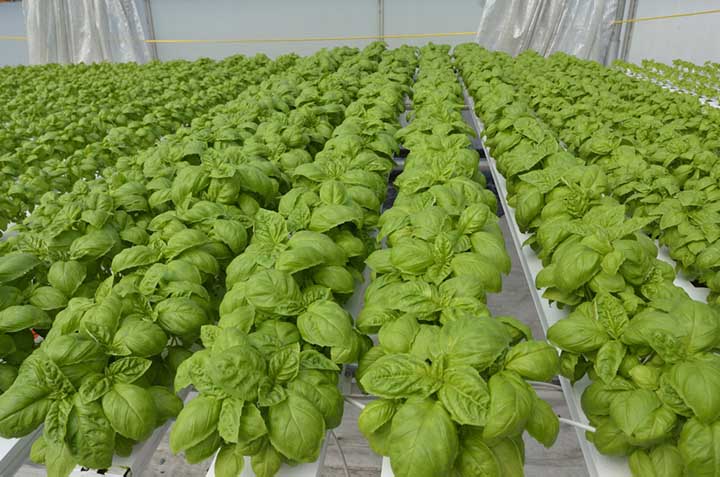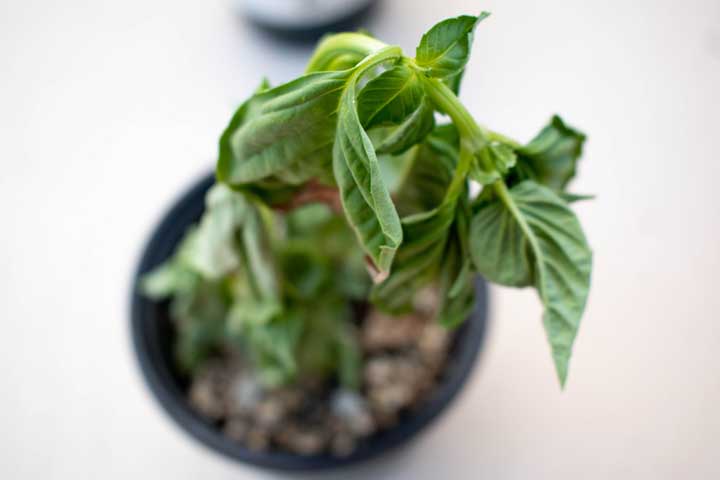Lots of people grow basil to cook with. Basil is not hard to grow but does have some disease problems. If your basil is in trouble, you may wonder, “Why is My Basil Root Rotting?”
You may be frustrated because your basil is having trouble. This guide discusses root rot causes and how to prevent them.
Why Is My Basil Root Rotting?
Basil root rot is caused by two types of fungus that attack stressed plants. Root rot is almost always caused by overwatering in basil grown in the soil. In hydroponically grown basil, root rot is caused by a lack of sanitation, contaminated plant tissue, or contaminated water.
Table of Contents
What Does Basil Root Rot Look Like?
Root rot looks slightly different in basil growing in soil versus basil grown hydroponically.
Basil Grown In Soil
Because you can’t see the roots in the soil, you will have to observe the above-ground portion of the plants.
The plant will first start wilting during the day. As the rot progresses, the basil will stay wilted even if you water it.
Next, leaves start to drop off. As the rot gets worse, the stem may soften.
Finally, the rot will travel throughout the plant. Between the rot and the lack of water and nutrients from the rotted roots, the plant collapses and dies.
Hydroponic Basil
First, the plants wilt or turn brown at the tips. Next, roots will turn brown and have very few fine root hairs. They may slough off the outer layer of the roots. They may also be soft or stunted. Finally, the roots turn black and collapse.
What Causes Root Rot In Basil?
Root rot is caused by several fungi (Pythium spp. or Rhizoctonia spp.) These fungi are opportunistic and tend to hit already overstressed plants.
Overwatering basil grown in soil is a primary cause of root rot. In hydroponic systems, root rot can result from failing to properly clean the system between crops, planting infected plant tissue, or contaminated water.
The older the nutrient solution is, the more likely it is to become contaminated with root rot fungi.
Can You Save A Basil Plant With Root Rot?
That depends on how fast you realize root rot is occurring—the earlier the treatment, the better the chance you can save your basil.
How Do You Treat Root Rot?
There are some things you can try. However, their success depends on diagnosing the root rot as early as possible.
Basil Grown In Pots
- Remove the basil from the pot
- Trim off brown or black roots
- Wash the roots clean with fresh water
- Plant the basil in a fresh pot with new potting soil
- Do not overwater the basil
Basil Grown In The Ground
Usually, it is too late to save the plant when the basil shows symptoms. However, you can try treating the basil as if it is a pot plant.
First, follow the above steps and replant the basil in a new area with better drainage. Whether that works depends on how badly the roots are damaged. If the roots are badly damaged, you may have to remove the top third of the foliage to give the roots a chance to grow without having to support so much foliage.
Finally, if very few roots are left, the plant will probably die.
Hydroponically Grown Basil
Root rot can quickly spread to all the plants in a hydroponic system. The steps below will salvage as many plants as possible.
- Stop the hydronic system.
- Remove all dead or diseased plants.
- Put the dead plants in the trash, not the compost pile.
- Cut the rotting roots off of the plants that are still alive.
- Wash the remaining roots well in clean water.
- Get rid of the contaminated nutrient solution.
- Start the system again and put new nutrient solution in.
- Keep the temperature around 70 degrees.
- Pump air into the system for the next several days to kill any remaining fungus.
How Do You Prevent Root Rot In Basil?
Root rot is usually preventable. Here are some ways to keep your basil safe.
Basil Grown In Soil
High humidity, crowded plants, and overwatering are prime risk factors for root rot, so control what you can.
- Do not overwater basil.
- Do not get water on the foliage.
- Work organic matter such as compost into the soil before planting basil to improve the drainage in the soil.
- Put three inches of mulch around the basil plant to absorb water.
- Keep the soil evenly moist but not soggy. A moisture meter is helpful to determine if the basil needs water.
- Make sure air can circulate around the plant.
Basil Grown In Pots
Use only sterilized potting soil. Before you reuse pots, wash them with soap and water, then soak them in bleach water for 30 minutes.
Do not overwater or over-fertilize the basil. A moisture meter is helpful here, too. When watering, do not get water on the foliage.
Basil Grown Hydroponically

Growing basil hydroponically is a bit more complicated than growing basil using soil. Here are some prevention tips.
- Wash the entire system with a bleach or hydrogen peroxide solution intended for hydroponic systems between crops.
- Use only verified disease-free seeds or transplants.
- Filter your water before adding it to the system, especially if you use surface water.
- Do not over-fertilize. For basil fertilizer in more detail, read my article here.
- Keep the level of oxygen in the water at the proper level.
- Keep the nutrient solution at around 70 degrees.
Frequently Asked Questions
Can You Eat Basil With Root Rot?
Yes, you can eat basil with root rot if it has not wilted too much. As the root rot progresses, the taste of the basil will deteriorate.
Is any variety of basil immune to root rot?
No, no variety has been developed that doesn’t get root rot.
Can companion planting keep basil from getting root rot?
No, basil companion planting will not help.
In summary, the leading causes of root rot are fungus. The number one way to avoid root rot in basil planted in the soil is to avoid overwatering. Keep the soil evenly moist but not soggy. Using a moisture meter is helpful to see if the basil needs watering. In hydroponically grown basil, sanitation is paramount. Sometimes you can save basil from root rot if you diagnose it soon enough.
